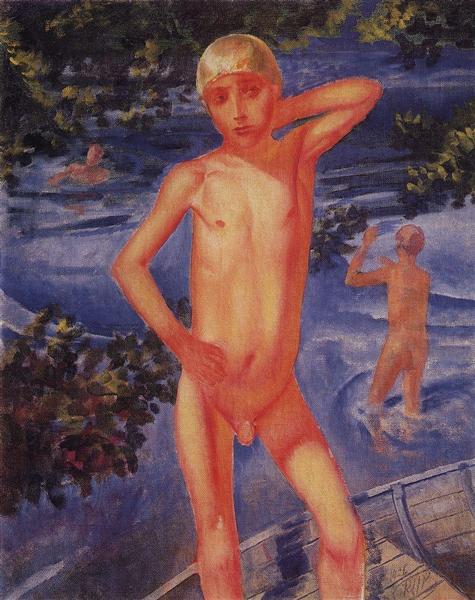Description
The painting "bathing children" (1926) by Kuzma Petrov-Vodkin is a work that captures the essence of everyday life with a simplicity and emotional depth that resonate with the spectator beyond the surface. In this piece, Petrov-Vodkin, a Russian artist known for his innovative approach and his ability to merge reality with the ideal, presents a scene in which three children are bathing in a natural environment.
At first glance, the work stands out for its balanced composition and color use. Petrov-Vodkin uses a predominantly warm color palette, with earthly tones and soft nuances that evoke a feeling of calm and serenity. The main colors, which oscillate between ocher and brown brown, complement themselves with sky blue and the green of the environment, creating a subtle but effective contrast that brings vitality to the scene without subtracting naturalness. Chromatic harmony reinforces the connection between the characters and their surroundings, suggesting a symbiosis between the human figure and the landscape.
The disposition of children in the composition is carefully thought. They are located in different but interconnected positions, forming a kind of triangle that guides the viewer's gaze through paint. This triangular structure is a classic technique that Petrov-Vodkin manages with a mastery, giving dynamism to the scene while maintaining a sense of cohesion and balance. The bodies of children, represented with subtle but precise anatomical precision, show a domain of drawing and a deep understanding of the human form.
Petrov-Vodkin is distinguished by its unique style that combines elements of Russian symbolism with European influences, particularly post-impressionism and fauvism. In "bathing children", we can observe these influences in the treatment of water and landscape, where reality intermingles with a certain poetic idealization. Water is represented with a lyrical transparency, a mirror that reflects not only the bodies of children but also the light and color of the environment.
In addition, Petrov-Vodkin introduces a slightly distorted perspective, a distinctive characteristic of his work that adds an almost dreamlike dimension to painting. This curvilinear perspective, which could be derived from its interest in spherical projection, prevents the scene from being limited to a mere realistic representation, inviting the viewer to a deeper reflection on the relationship between space, time and human experience.
The fact that Petrov-Vodkin painted this work in 1926, during a period of great socio-political transformations in Russia, can also be read as a meditation on innocence and simplicity in times of change. The scene, apparently trivial and everyday, acquires a greater resonance when considered the historical context, which suggests an assessment of childhood purity and the perpetuation of primary moments of human experience.
In conclusion, "bathing children" is a testimony of the talent of Kuzma Petrov-Vodkin to capture the essence of daily life through an emotional depth lens and refined artistic technique. The work is not only a representation of a bathing scene, but an exploration of human interaction with its environment, a reflection on innocence and purity in a constant change. Petrov-Vodkin, with its ability to merge the real and ideal, gives us a piece that transcends the simple observation to become a visual meditation on the human condition.
KUADROS ©, a famous paint on your wall.
Hand-made oil painting reproductions, with the quality of professional artists and the distinctive seal of KUADROS ©.
Art reproduction service with satisfaction guarantee. If you are not completely satisfied with the replica of your painting, we refund your money 100%.

